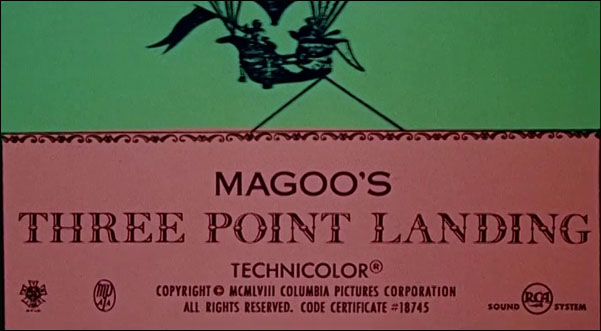
Here’s a rare treat for this week’s column—an animator breakdown for a UPA Mister Magoo! Since this is a fairly standard Magoo entry, this should feel like a good opportunity to discuss the individual artists credited here.
By 1957, around the time Magoo’s Three-Point Landing was nearly in post-production, the Mister Magoo cartoons dominated UPA’s release schedule, as the studio’s one-shot cartoons were terminated. Many of the stories on the Magoo films were credited to Dick Shaw, who began his animation career at Disney’s in the early 1940s. Shaw was a freelance cartoonist before he joined Disney, and regularly sold his artwork to magazines such as The Saturday Evening Post, Collier’s and Liberty. He often partnered with Virgil “Vip” Partch and Hank Ketcham (later notable for the Dennis the Menace comic strip) in brainstorming sessions for their magazine cartoons during the 1941 strike and after. Shaw and Partch are credited together in one Disney film, Jack Kinney’s Duck Pimples (1945), one of the more imaginative films from the studio during that period.
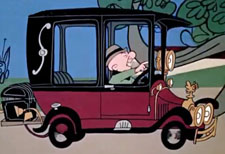 Ed Friedman is credited as an animator on this film, along with Gil Turner, Barney Posner and Maurie Faigin (the latter’s name misspelled as “Fagin” in the film’s credits). Friedman animates a few extended sequences in this film, as Magoo and his vehicle (named “Louise”) are left stranded at an airport runway. Thinking he is on a highway, he sticks out his thumb to hitch a ride and indignantly shouts as each aircraft that passes him. Friedman follows the dialogue track quite well in these scenes, with sharp poses and lip-sync.
Ed Friedman is credited as an animator on this film, along with Gil Turner, Barney Posner and Maurie Faigin (the latter’s name misspelled as “Fagin” in the film’s credits). Friedman animates a few extended sequences in this film, as Magoo and his vehicle (named “Louise”) are left stranded at an airport runway. Thinking he is on a highway, he sticks out his thumb to hitch a ride and indignantly shouts as each aircraft that passes him. Friedman follows the dialogue track quite well in these scenes, with sharp poses and lip-sync.
Friedman began his career in the early ‘30s at Ub Iwerks’ studio, and later moved to Charles Mintz’s studio. He remained at the studio when it changed its name to Screen Gems by the late 1940s (Friedman is credited as one of the story men for the 1946 Flippy cartoon Silent Tweetment.) He worked at various studios throughout his career including John Sutherland Productions, Paramount’s King Features Syndicate (Popeye), Format Films, Ed Graham, and finally, promoted from animator to director at Filmation. He passed away in 2005 of complications from a stroke.
Bob Dranko is credited for “design” on many of the Magoo cartoons, including this film. He studied art at Los Angeles City College and Chiounard Institute before he joined UPA, where he gained a reputation for his design and color styling on The Unicorn in the Garden (1953). Later, his talents led him to serve as an art director on the studio’s first feature 1001 Arabian Nights (1959). Dranko left UPA to do freelance work for studios such as Jay Ward, Playhouse Pictures, John Sutherland and Fred Calvert, but returned to UPA as a character designer on The Famous Adventures of Mr. Magoo television series. Subsequently, he worked for Hanna-Barbera, Ralph Bakshi (Heavy Traffic), DePatie/Freleng in the 1970s. In the late ‘80s, Dranko was an assistant director at TMS and a storyboard arist for DiC Animation before his retirement in 2004.
Raised in Stockton, California, as a teenager, background artist Bob McIntosh’s fine arts upbringing was stirred by Harry Noyes Pratt (1879-1944), the director of the Haggin Museum—newly opened at the time in 1931—along with the mentorship of painter Arthur Haddock (1895-1980). McIntosh applied for a scholarship to the Art Center in Los Angeles (now known as Art Center College of Design in Pasadena). He was soon able to re-locate with his moved his family to Los Angeles in 1934. Soon after, he was hired at Disney’s studio, working on some of the animated features as a background painter, particularly Bambi (1942). Like many artists in the animation field during World War II, McIntosh was drafted into the First Motion Picture Unit.
Following his discharge from the service, he joined Paul Fennell’s Cartoon Films Ltd., where he worked on commercial films. He joined UPA in the early ‘50s and remained there for the entire decade as a background painter. After UPA, Bob worked at Format Films (The Alvin Show, The Lone Ranger), Ed Graham, Jay Ward Productions (George of the Jungle), Chuck Jones (The Phantom Tollbooth) and Hanna-Barbera before retiring in the early 1980s.
UPA seemed to have adopted the term “sweatbox” after scrutiny over the animators’ scenes from the Disney studio’s similar methods in a tight projection room. These notes, sourced from the estate of director Pete Burness, are dated September 6, 1957; Magoo’s Three-Point Landing was released several months later on June 5, 1958. In these notes, suggestions for correcting animation and special effects are recorded for each of the animator’s scenes. One artist credited only for scene 5 as “Anna” (for scene 5) I could not identify; presumably, she could have been an assistant animator due to her one scene in the film. Mindy Johnson (author of the outstanding women-in-animation reference Ink and Paint) suspects its Anna Osborn (or – Osborne). Says Mindy, “She was an Assistant Animator at UPA and also worked at MGM, Disney (though still verifying when), WB (Friz Freling unit) and at HB in the early 80s…”
For now, this is the last UPA breakdown, as only two other documents (a draft of Grizzly Golfer and a partial draft of Magoo Goes Overboard) are what is currently accessible. This is also the last column for a month, since I took it upon myself to take a hiatus for the month of November. It might seem effortless to write about animation research, but it takes a lot out of me, and sometimes I need to take a break to recharge. Of course, I’m always looking forward to everyone’s reactions to the weekly columns, and I’m hoping to expand the column a little further with new topics and ideas. I’ll see you all in December, with more posts about moonlighting animators in comics!
Enjoy!
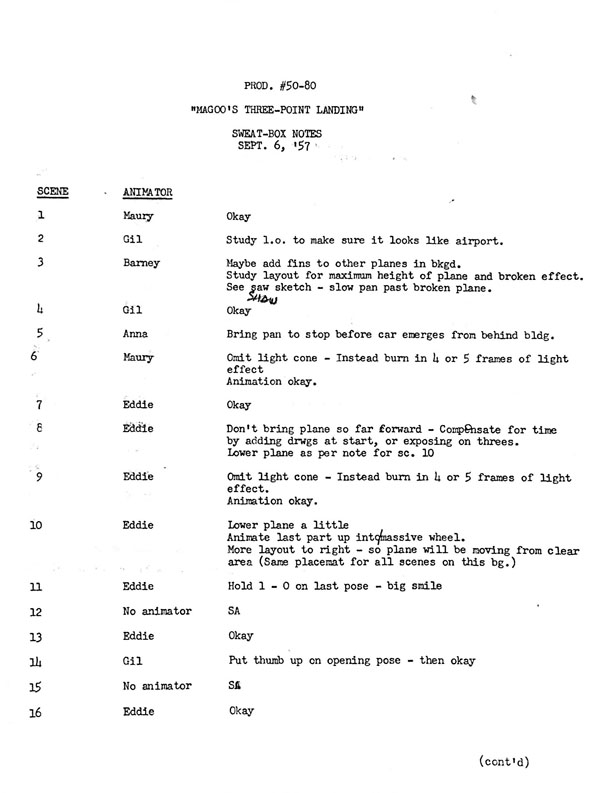
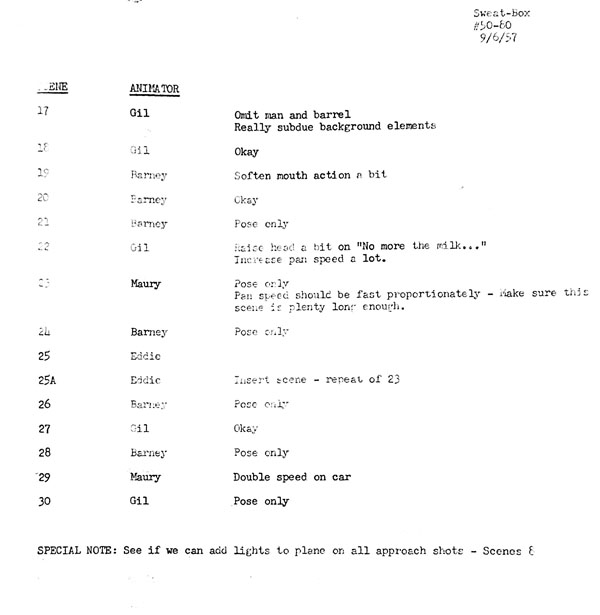
(Thanks to Adam Abraham and Patrick Malone for their help)


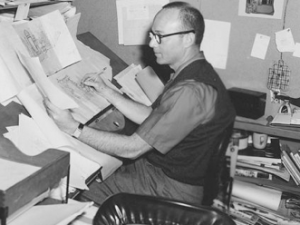
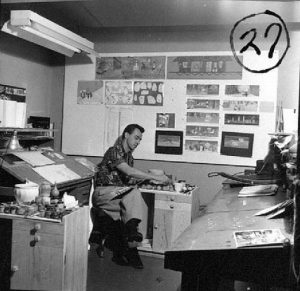
 DEVON BAXTER is a film restoration artist, video editor, and animation researcher/writer currently residing in Pennsylvania. He also hosts a
DEVON BAXTER is a film restoration artist, video editor, and animation researcher/writer currently residing in Pennsylvania. He also hosts a 





















































































I am really enjoying your weekly columns, whether comic book related or the breakdowns .As far as the Magoo’s : I grew up watching him (TV & Theatrical) and he is perhaps my favorite.I realize Magoo is not everyone’s cup- of- tea, but for me even a “fairly standard Magoo entry” is very much appreciated and enjoyed ! Keep up the good work . (dja)
An uncredited Daws Butler voices the co-pilot, sounding very close to Mr. Jinx.
Devon,
I’ll probably never be able to tell one person’s animation from another, but I love all the work you put into these articles, especially the mini-bios of the artists who worked on the cartoons. (And I’m always amazed at how often they switched from one studio to another!)
So thanks for all the work you put into these posts. (Heck, it takes me many, many minutes just to compose a work email of a few sentences!) And enjoy your vacation!
Anna Osborn! The lady who animated who animated the mouths in the SPEAKING OF ANIMALS shorts.
Did you notice that the pilot, who says he is known for his emergency landings, is named Sully?
Mr. Magoo was good between 1949 and 1955. When Bill Scott left for Jay Ward, that was the end of that studio. (Not even Chuck Jones could save that studio.)